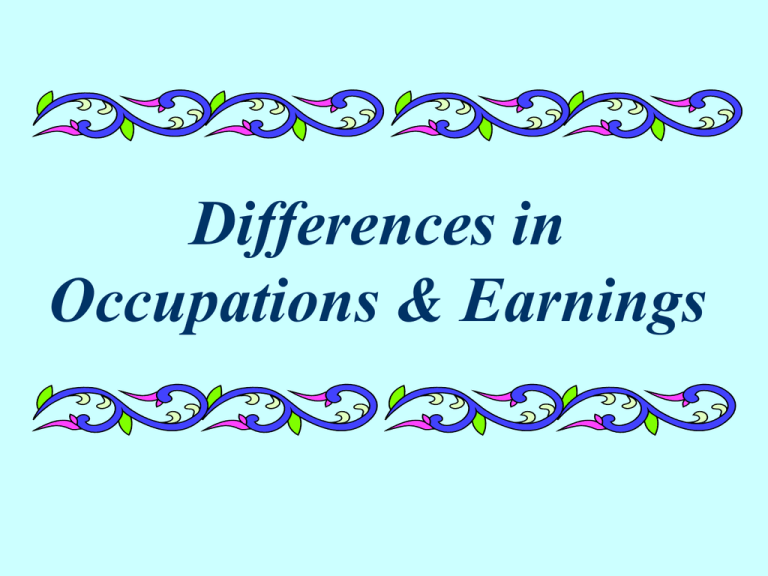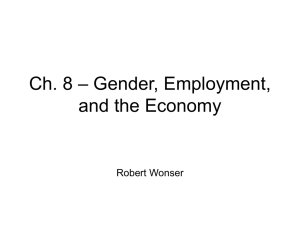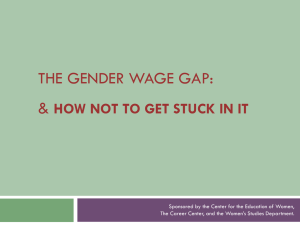
Differences in
Occupations & Earnings
How do occupations differ by
race/ethnicity and gender?
Let’s first look at men.
The highest percentages of non-Hispanic White men are in management
and professional occupations.
The highest percentages of Black men are in services and transportation.
The highest percentages of Asian men are in professional occupations.
The highest percentages of Hispanic men are in services and construction.
What about the women?
The women tend to have high percentages in professional occupations,
services, and administrative support.
The highest percentages of Non-Hispanic Whites and Asian women
are in professional occupations, while the highest percentages of
Black and Hispanic women are in services.
We can measure the extent of the differences
in the occupational distributions of men and
women using the index of occupational
segregation.
Index of Occupational Segregation
This index measures the percentage of females
(or males) that must change jobs in order for
the occupational distributions to be equal. It is
calculated as follows:
½ |Mi – Fi|
Where Mi is the percentage of males in the
labor force in occupation i, and Fi is the
percentage of females in the labor force in
occupation i
Example 1: Complete segregation
100% of all men in blue-collar jobs
100% of all women in pink-collar jobs
½ [|100-0| + |0-100|] = 100
Occupation
Men
Women
Blue-Collar
100
0
Pink-collar
0
100
Total
100
100
This means that 100% of
women would have to change
to blue-collar jobs or 100% of
men would have to change to
pink-collar jobs for the
occupational distributions to
be the same.
Example 2: Complete integration
40% of men in blue-collar jobs, 60% in pink-collar jobs
40% of women in blue-collar jobs, 60% in pink-collar jobs
Occupation
Men
Women
Blue-Collar
40
40
Pink-collar
60
60
Total
100
100
½ [|40-40| + |60-60|] = 0
This means that no one
needs to change jobs to
make the occupational
distributions the same for
the two genders.
Example 3: High integration
60% of men in blue-collar jobs, 40% in pink-collar jobs
40% of women in blue-collar jobs, 60% in pink-collar jobs
Occupation
Men
Women
Blue-Collar
60
40
Pink-collar
40
60
Total
100
100
½ [|60-40| + |40-60|] = 20
This means that 20% of
men would have to change
to pink-collar jobs or 20%
of women would have to
change to blue-collar jobs
to make the occupational
distributions the same.
Example 4: Low integration
80% of men in blue-collar jobs, 20% in pink-collar jobs
20% of women in blue-collar jobs, 80% in pink-collar jobs
Occupation
Men
Women
Blue-Collar
80
20
Pink-collar
20
80
Total
100
100
½ [|80-20| + |20-80|] = 60
This means that 60% of
men would have to change
to pink-collar jobs or 60%
of women would have to
change to blue-collar jobs
to make the occupational
distributions the same.
The very broad categories discussed previously do not
show the full extent of occupational segregation.
There is also occupational segregation in sub-categories.
Consider, for example, the professional occupations.
Women comprise a high percentage of workers who are
dietitians, librarians, nurses, pre-school and kindergarten
teachers, and elementary school teachers, while men
represent a high percentage of workers who are
architects, engineers, clergy, dentists, and computer
scientists and systems analysts.
Index of Occupational Segregation
by Sex, 2009
51.0%
So about half of women (or men) would have to
change jobs for the occupational distribution of
the two groups to be the same.
Even the Index of Occupational Segregation
calculations based on the detailed census
occupational categories likely underestimates
the full extent of employment segregation by
sex.
Job categories used by employers are even
more detailed and would likely reveal more
segregation.
Also, particular firms often employ mostly
men or mostly women, such as women in sales
are heavily represented in clothing stores but
not in electronics stores.
Not only do men and women tend to work in
different occupations, but they also tend to be
employed at different levels of the hierarchy
within occupations.
Example:
University Faculty, 2011-2012
Rank
Percent Female
Full Professors
28
Associate Professors
43
Assistant Professors
50
Instructors
61
To the extent that occupational segregation
is due to socially imposed restrictions,
removal of those barriers would increase
efficiency and decrease frustration, since
individuals could seek work suited to their
particular aptitudes.
However, even if social barriers were removed
immediately, the rate of change of occupational
segregation is limited by the time it takes for
new people to be trained.
Past socialization also affects the preferences of
people already in the work force. Less gender
bias in the socialization of girls and boys would
reduce the amount of occupational segregation,
but it would take many years for these girls and
boys to grow up and enter the labor force.
Occupational integration is a very slow process.
Let’s move now from discussing
occupational segregation
to examining
earnings differentials.
Female/Male Earnings Ratio
Throughout the 1960s and 1970s, the ratio of
female-to-male earnings for full-time, yearround workers hovered close to 59%.
Over the last 30 years, it increased to 77% in
2011.
Note that this means that women still earn
only slightly over ¾ of what men earn.
The gap between men’s and women’s
earnings tends to widen with age.
There are several possible explanations, which are
not mutually exclusive.
The current younger cohort has choices more
similar to those of men than the older cohorts had.
The younger cohort is not facing as much
discrimination as the cohorts before them.
Women accumulate less experience than men, on
average, as they age.
Women face greater barriers to advancement at
higher levels of the job hierarchy.
Female-to-Male Earnings Ratios by Education, 2011
Education
1-3 yrs of
high school
4 yrs of
high school
1-3 yrs of
college
4 or more yrs
of college
F/M (%)
66.7
70.0
71.1
69.0
Women at each level of
education earn less than
similarly educated men.
Female-to-Male Earnings Ratios for Full-Time,
Year-Round Workers by Race/Ethnicity, 2011
Whites
77.1
Blacks
85.4
Asians
74.9
Hispanics
91.1
Hispanic and Black women earn more relative to men of the same
race/ethnicity than White and Asian women do relative to White
and Asian men. (Keep in mind, however, that the Hispanic and
Black men are earning a lot less than the White and Asian men.)
Earnings Ratios for Full-Time,
Year-Round Workers, 2011
Earnings ratios
Males
Females
Black-to-White
74.7
82.8
Asian-to-White
104.6
101.7
Hispanic-to-White
60.9
71.9
Relative earnings are lower for Hispanics than for Blacks.
Hispanic and Black women earn more relative to White
women than Hispanic and Black men earn relative to White
men. (Remember however, that the White women are earning a
lot less than the White men.)
Sexual Orientation
Statistical analysis has been used to study the effects of
sexual orientation on earnings.
This research has generally found that gay men earn
less than heterosexual men, while lesbians earn more
than heterosexual women.
Same-sex marriage has historically been illegal in most
states. Gay men and lesbians may therefore have been
less likely to pursue a traditional division of labor with
their partners. That behavior may be one factor
contributing to the observed earnings differentials.
In addition, the lower earnings of gay men may be due
in part to discrimination.
The earnings premium of lesbians may mask some
discrimination against them.
Lesbians may have characteristics - such as greater
career orientation - that lead to greater productivity.
Discrimination may partially offset that effect on wages.
So their wages (though higher than heterosexual
women) may not fully reflect their higher productivity.
In addition, gay men and lesbians may trade off higherwage jobs for positions that are more open to sexual
minorities.
There is little research on earnings of bisexuals.
An interesting study of transgender individuals sheds
light on the consequences of such transitions.
The study examined the labor market outcomes of people who
changed their gender, generally with hormone therapy and
surgery.
This research found that the average earnings of individuals who
changed their gender from female to male increased slightly,
while the average earnings of individuals who changed their
gender from male to female fell by one-third.
The authors of the study noted that their findings were consistent
with reports that “for many male-to-female workers, becoming a
woman often brings a loss of authority, harassment, and
termination, but that for many female-to-male workers, becoming
a man often brings an increase in respect and authority.”
Kristen Schilt and Matthew Wiswall (2008) “Before and After: Gender Transitions, Human
Capital, and Workplace Experiences,” The B.E. Journal of Economic Analysis & Policy, 8, no. 1,
Article 39. Available at: http://www.bepress.com/bejeap/vol8/iss1/art39 .
Returning to the gender wage gap …
Gender differences in earnings are due to
many forces, including:
• differences in the characteristics that men
and women bring to their jobs (education,
training)
• differences in the characteristics of the
jobs that men and women do
• discrimination









